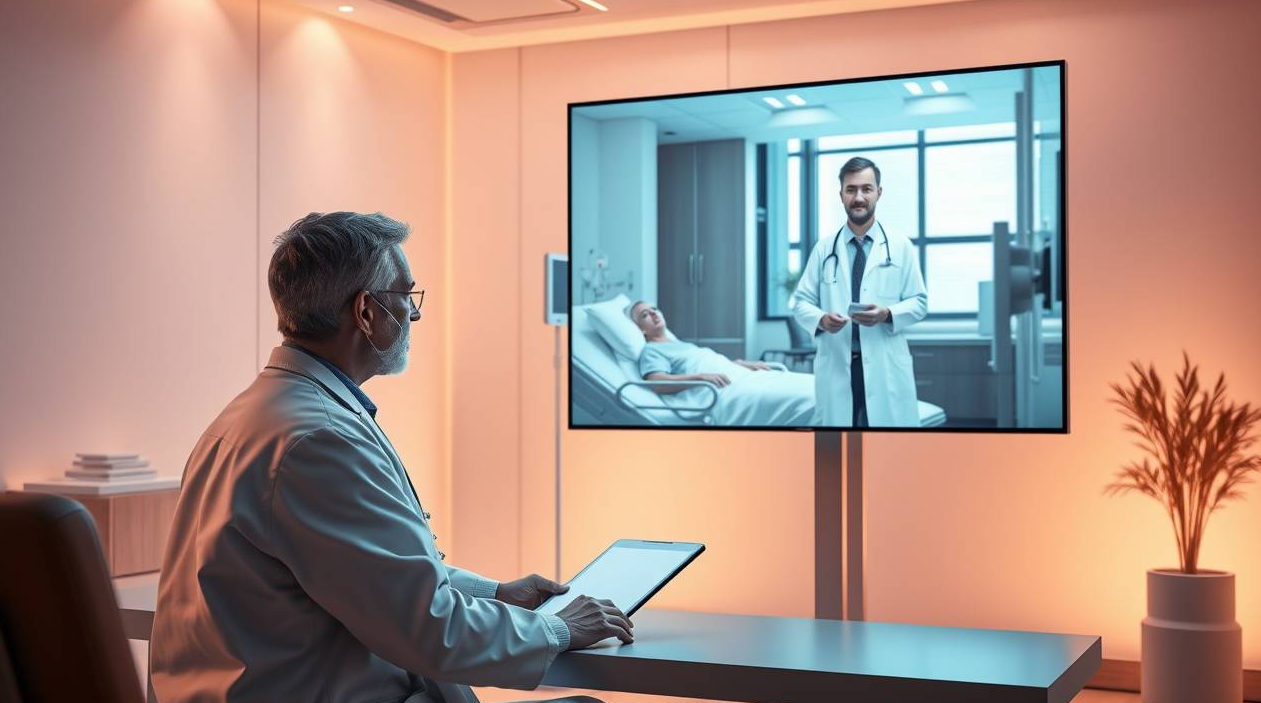Tele-ICUs are transforming the way critical care is delivered by integrating advanced telehealth technologies, enabling remote monitoring, addressing staffing shortages, and improving patient outcomes through real-time data and expert collaboration.
Critical care is constantly evolving in response to the need for improved and more efficient patient management. Tele-ICUs are a key part of that, bringing together technology, medical expertise, and instant communication. Telehealth technologies and AI-driven analytics have significantly advanced ICU real-time monitoring, enabling remote patient care like never before.
Role of Tele-ICU in Critical Care
Tele-ICUs offer a centralized platform for medical personnel to remotely monitor critically ill patients across multiple locations, improving access to specialist care. They are especially valuable for smaller or rural hospitals that lack 24/7 intensivist coverage, ensuring continuous oversight and timely intervention.
A tele-ICU system consists of several components working in a highly coordinated fashion:
- Sophisticated Patient Monitoring Devices: These devices, often integrated directly with the patient, capture a wide range of vital signs and other crucial physiological data, including heart rate, blood pressure, oxygen saturation, respiratory rate, and even more advanced metrics. This data stream provides a continuous, real-time snapshot of the patient’s condition.
- Advanced Audio-Visual Equipment: Telehealth cameras are not simple webcams. They are sophisticated, high-resolution imaging devices with remote pan, tilt, and zoom (PTZ) capabilities, allowing clinicians to conduct thorough and detailed visual assessments of patients from a remote location. Systems have AI-powered features within the camera network, such as automated fall detection, which instantly alerts care providers if a patient falls, and advanced analytics that can detect subtle changes in patient appearance that might indicate distress.
- Tele-ICU Software Platform: These platforms serve as the central control system that provides a unified, user-friendly interface for data visualization, advanced analytics, and communication. Often integrated with EHR systems, they allow clinicians to access real-time patient data, review historical trends, participate in video consultations with on-site staff, and document their findings, all within a secure and integrated environment.
- High-Bandwidth Network Infrastructure: Underpinning the entire system is a robust and reliable network infrastructure. This is essential for seamless and uninterrupted data transmission, especially high-quality video feeds that require significant bandwidth. Redundancy and fail-safe mechanisms are crucial to maintaining continuous operation in the event of network disruptions.
Addressing Challenges with Tele-ICU

The implementation of tele-ICUs offers tangible and significant solutions to many of the most pressing challenges facing modern healthcare.
Custom Table
| ICU Challenge |
How Tele-ICU Addresses It |
| Staff shortages and burnout |
Tele-ICUs extend critical care coverage around the clock, relieving on-site staff by reducing routine tasks and offering immediate remote support. This not only optimizes patient care but also alleviates the stress and burnout experienced by front-line healthcare providers, as evidenced by a 2019 Medscape survey indicating over 24% of respondents found burnout relief by changing work settings. |
| Delayed emergency response |
When every second counts, AI-powered alerts within the tele-ICU system can detect subtle yet critical changes in a patient’s condition, often earlier than might be possible with traditional manual monitoring. This facilitates rapid intervention, potentially preventing adverse events and significantly improving patient outcomes. For instance, a Cleveland Clinic study showed an 18% reduction in mortality risk for tele-ICU patients. |
| Infection risks and personal protective equipment (PPE) shortages |
Infectious disease outbreaks and shortages of PPE pose significant challenges. Remote monitoring via telehealth cameras reduces the need for direct patient contact, preserving precious PPE and minimizing the risk of infection transmission to both healthcare providers and other patients. |
| Communication gaps |
Tele-ICUs foster collaboration by establishing centralized command centers where all members of the care team, regardless of their physical location, can access real-time patient data, participate in video conferencing, and communicate through secure messaging. This eliminates communication silos and ensures coordinated care. |
| Lack of data insights |
Modern ICUs produce overwhelming amounts of data. Tele-ICUs provide tools to unlock the power of this data. AI-driven analytics can track patient trends, detect subtle patterns of deterioration, and provide clinicians with actionable information to make more informed and timely decisions, leading to proactive interventions and ultimately improving patient outcomes. |
Case Study
As the experience at a private hospital in New Taipei City shows, AVer cameras with auto tracking and PTZ capabilities in a tele-ICU setup have significantly enhanced remote critical care. They provide crystal-clear video feeds that allow remote care providers to closely monitor patients, assess their condition, and collaborate effectively with on-site staff. The camera’s remote zoom function allows for detailed visual examinations and mimic the level of scrutiny possible in an in-person visit. Combined with real-time data streaming from other monitoring devices, remote teams can provide timely and effective support to the bedside staff, effectively extending the reach of critical care expertise.
Key Takeaways
Tele-ICUs, powered by advanced telehealth cameras, sophisticated software, and a robust network, are transforming critical care. They address staffing shortages and burnout, speed up emergency response, improve interprofessional communication, and offer data-driven insights, all leading to better care for critically ill patients. By connecting on-site and remote medical expertise and resources, tele-ICUs will continue to help shape the future of healthcare.
References